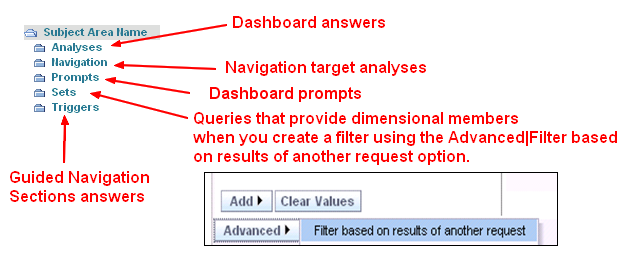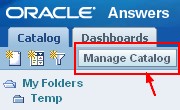About
The Web Catalog becomes in 11g the Presentation Catalog. Be careful not to confuse with the Old Presentation Catalog term of the Presentation Layer from the repository in 10g …
The Oracle BI Presentation Catalog stores BI Presentation Service object such as:
- folders,
- shortcuts,
- from 11G
KPIs,
- from 11G
Oracle BI Publisher objects (such as reports and templates).
in a directory structure of individual files.
This object are generally created with the BI Presentation Services Dashboard.
Each object is composed of two files:
- its own file. For example, an analysis called Analysis 1 would be stored in a file named Analysis1.
- a attributes file. For example, the analysis called Analysis1 would have a corresponding attributes file named Analysis1.atr.
The attributes file contains:
- the object's full name,
- access control list (ACL),
- description,
- and so on.
To access an object in the catalog, users must have appropriate ACL entries for that object. All objects in the catalog use ACL entries.
In 11g, the Everyone group has been replaced with the AuthenticatedUser role
Articles Related
Directory structure
When opening a webcatalog, you will always find the following folders
- The shared folder— Contains content that is shared among catalog users. Dashboards that are shared across users are saved in a Dashboards subfolder under a common subfolder under the /Shared Folders folder.
- The system folder — Contains administrative elements of Presentation Services. Some of these elements are distributed with the product, and others are set up by the administrator, such as privileges.
- The users folder — Contains content that catalog users with the appropriate permissions have saved to their personal folders, such as individual analyses. Includes a Subject Area Contents folder where you save objects such as calculated items and groups.
from 11.9:
/users/<user>/_delivers
/users/<user>/_portal
/users/<user>/_filters
/users/<user>/_selections
/users/<user>/_savedcolumns
/users/<user>/_thumbnails
/users/<user>/_internals
Structure of a web catalog
A way to classify queries used in an analytic application is to group them according to their function:
- analyses that appear on dashboards,
- analyses that are navigation targets,
- analyses that provide dimensional sets,
- analyses that serve as triggers, and dashboard prompts.
It makes sense to structure the web catalog to reflect these five classifications. With a top level folder for each subject area, the web cat folder structure looks like this:
Samplesales demo data set makes a difference between column prompt (to filter a column) and other prompt purpose.
Catalog Administration Tool
Web
Oracle BI Presentation Service provides a pure browser-based administration tool to administer a Web Catalog.
Administrators can:
- control which users can access what dashboards
- set user privileges
- create and manage groups and roles
- change group membership lists
- re-name or delete catalog folders
- and saved analyses,
- and view and manage sessions.
Catalog Manager GUI
The installation of OBIEE provides also a desktop tool: the catalog manager
Runcat client
The runcat utility is a command line tool.
Management
Location
The webcatalog is located:
- on 10G: OracleBIData/web/catalog/
- on 11G: ORACLE_INSTANCE/bifoundation/OracleBIPresentationServicesComponent/catalog/
- on 12c: ORACLE_HOME\user_projects\domains\bi\bidata\service_instances\ssi\metadata\content\catalog where ssi is a service instance
Archive / Unarchive or Copy (Promotion)
Rename an Object
There are two ways to rename an object:
- Rename without reference updates — Renames the object and preserves the references to the original name that other catalog objects might have.
- Rename with reference updates — Renames the object and changes references that other objects might have to the new name (that is, original name references are not preserved). You must open the catalog in offline mode.
Do not rename the “My Dashboard” dashboards in the Users folder (displayed as _portal in Catalog Manager).
Repair
With runcat
runcat.sh -cmd repair -offlineRaw $CAT_PATH -outputFile $(pwd)/repair.log
Delete an object (or a dir)
With runcat
runcat.sh -cmd delete -path '/shared/shared' -offline $CAT_PATH
To delete a user or its content, see account managment
full-text catalog search
Only on 11g
A search engine can be configured to crawl and index the Oracle BI Presentation Catalog to be able to perform a full-text catalog search for objects and attachments. More … Configuring for Full-Text Catalog Search

